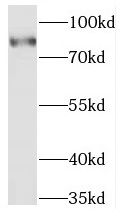Products
MARK2 antibody
Category:
Research Area:
- SPECIFICATIONS
- Product Name
- MARK2 antibody
- Catalogue No.
- FNab05013
- Size
- 100μg
- Form
- liquid
- Purification
- Immunogen affinity purified
- Purity
- ≥95% as determined by SDS-PAGE
- Clonality
- polyclonal
- Isotype
- IgG
- Storage
- PBS with 0.02% sodium azide and 50% glycerol pH 7.3, -20℃ for 12 months(Avoid repeated freeze / thaw cycles.)
Immunogen
- Immunogen
- MAP/microtubule affinity-regulating kinase 2
- Alternative Names
- EMK1 antibody
- UniProt ID
- Q7KZI7
- Observed MW
- 77-90 kDa
Application
- Tested Applications
- ELISA, WB, IHC, IP
- Recommended dilution
- WB: 1:500-1:2000; IP: 1:200-1:1000; IHC: 1:20-1:200
Validated Images
 mouse brain tissue were subjected to SDS PAGE followed by western blot with FNab05013(MARK2 antibody) at dilution of 1:1000
mouse brain tissue were subjected to SDS PAGE followed by western blot with FNab05013(MARK2 antibody) at dilution of 1:1000
 IP Result of anti-MARK2 (IP:FNab05013, 4ug; Detection:FNab05013 1:1000) with rat brain tissue lysate 4000ug.
IP Result of anti-MARK2 (IP:FNab05013, 4ug; Detection:FNab05013 1:1000) with rat brain tissue lysate 4000ug.
 Immunohistochemistry of paraffin-embedded human prostate cancer using FNab05013(MARK2 antibody) at dilution of 1:50
Immunohistochemistry of paraffin-embedded human prostate cancer using FNab05013(MARK2 antibody) at dilution of 1:50
- Background
- Serine/threonine-protein kinase involved in cell polarity and microtubule dynamics regulation. Phosphorylates CRTC2/TORC2, DCX, HDAC7, KIF13B, MAP2, MAP4, MAPT/TAU, and RAB11FIP2. Plays a key role in cell polarity by phosphorylating the microtubule-associated proteins MAP2, MAP4 and MAPT/TAU at KXGS motifs, causing detachment from microtubules, and their disassembly. Regulates epithelial cell polarity by phosphorylating RAB11FIP2. Involved in the regulation of neuronal migration through its dual activities in regulating cellular polarity and microtubule dynamics, possibly by phosphorylating and regulating DCX. Regulates axogenesis by phosphorylating KIF13B, promoting interaction between KIF13B and 14-3-3 and inhibiting microtubule-dependent accumulation of KIF13B. Also required for neurite outgrowth and establishment of neuronal polarity. Regulates localization and activity of some histone deacetylases by mediating phosphorylation of HDAC7, promoting subsequent interaction between HDAC7 and 14-3-3 and export from the nucleus. Also acts as a positive regulator of the Wnt signaling pathway, probably by mediating phosphorylation of dishevelled proteins(DVL1, DVL2 and/or DVL3). Modulates the developmental decision to build a columnar versus a hepatic epithelial cell apparently by promoting a switch from a direct to a transcytotic mode of apical protein delivery. Essential for the asymmetric development of membrane domains of polarized epithelial cells.



